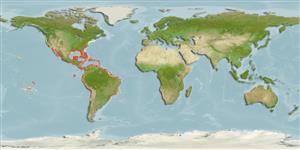Classification / Names
Common names from other countries
Main reference
Size / Weight / Age
Max length : 104 cm TL male/unsexed; (Ref. 7251); max. published weight: 10.0 kg (Ref. 37955)
Length at first maturity
Lm 48.8, range 21 - 36 cm
Environment
Marine; brackish; reef-associated; amphidromous (Ref. 51243); depth range 0 - 84 m (Ref. 13608), usually 1 - 15 m (Ref. 9268)
Climate / Range
Subtropical, preferred 26°C (Ref. 107945); 45°N - 31°S, 159°W - 35°W (Ref. 55166)
Distribution
Worldwide in warm seas. Hawaiian species have been verified by electrophoretic analysis (Ref. 5577), hence, Albula vulpes might be further split. Eastern Pacific: California, USA to Peru (Ref. 2850). Western Atlantic: North Carolina, USA to Florida, Bahamas, Gulf of Mexico, Antilles and Caribbean to Brazil (Ref. 26938). Northwest Atlantic: Canada (Ref. 5951). The West African form is Albula goreensis, Valenciennes, 1846.
Countries | FAO areas | Ecosystems | Occurrences | Introductions
Short description
Dorsal
spines
(total): 0;
Dorsal
soft rays
(total): 15-19;
Anal
spines: 0;
Anal
soft rays: 7 - 9;
Vertebrae: 69 - 74. Branchiostegal rays 12-14 (Ref. 4639). Silvery with dusky fins; base of pectorals yellow (Ref. 3970). Body elongate and fusiform (Ref. 4832). Last ray of dorsal and anal fins not prolonged; head region naked; spot and band absent on head; margin of nasal pore not black (Ref. 13608). Bluntly conical snout extends beyond inferior mouth (Ref. 26938). Pectoral and pelvic axillary scales present; a single long scale on each side of membrane between each ray of dorsal and anal fins (Ref. 4832).
IUCN Red List Status (Ref. 115185)
Threat to humans
Reports of ciguatera poisoning (Ref. 4690)
Human uses
Fisheries: minor commercial; gamefish: yes; bait: usually
More information
ReferencesAquacultureAquaculture profileStrainsGeneticsAllele frequenciesHeritabilityDiseasesProcessingMass conversion
Tools
Special reports
Download XML
Internet sources
Estimates of some properties based on models
Phylogenetic diversity index
PD50 = 0.5007 many relatives (e.g. carps) 0.5 - 2.0 few relatives (e.g. lungfishes)
Trophic Level
3.7 ±0.3 se; Based on diet studies.
Resilience
Low, minimum population doubling time 4.5 - 14 years (K=0.3; tm=2; tmax=20)
Vulnerability
Moderate vulnerability (43 of 100)
Price category
